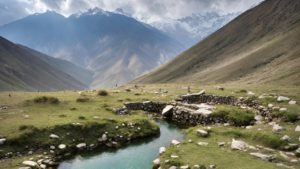Physical Address
23,24,25 & 26, 2nd Floor, Software Technology Park India, Opp: Garware Stadium,MIDC, Chikalthana, Aurangabad, Maharashtra – 431001 India
Physical Address
23,24,25 & 26, 2nd Floor, Software Technology Park India, Opp: Garware Stadium,MIDC, Chikalthana, Aurangabad, Maharashtra – 431001 India

By Aayushi Sharma
Millions of people in the 10 States and 4 hill districts of the Indian Himalayan Region (IHR) and their livestock rely primarily on springs for their water. Communities in both rural and urban areas rely on springs for their daily needs for drinking, domestic, and agricultural water. In the Indian Himalayan region and throughout the entire Hindu Kush Himalayan (HKH) region, which stretches from Afghanistan to Myanmar, there is mounting evidence that springs are drying up or decreasing in discharge. Mountain aquifer systems are being impacted by erratic rainfall, seismic activity, and ecological degradation linked to land use change for infrastructure development.
There is severe water shortage in thousands of Himalayan villages as a result of the reported drying up or seasonalisation of half of the more than three million perennial springs in IHR States. The quality of spring water is also a matter of concern. Studies that quantify the contribution of springs to the base flow of major Himalayan rivers are scarce. It is clear that springs play a significant role in base flow, perhaps even more so than glaciers, ice, and snow.
Impact of Climate Change on Himalayan Springs
Dr Suman Jumani, Post-doctoral Fellow, USACE-ERDC-EL told CFC India that “The impacts of climate change are most prominent in high altitude regions like the Himalayas, where global warming is resulting in significant glacial retreat and change in precipitation patterns. A warming climate in combination with unsustainable developmental activities, particularly blasting for infrastructure development and deforestation, has led to the destruction or degradation of several springs in the Himalayas. This can be catastrophic for the numerous communities that rely on natural springs as their only source of irrigation and drinking water, in addition to other cultural and traditional ties.”
“One example is the drying up of 35 water sources after the construction of the Karchham Wangto hydroelectric project in Himachal Pradesh that affected 5 villages. Due to an incomprehensive database of springs in the Himalayas and a lack of adequate impact assessments, the implications of drying or lost springs are not holistically documented or assessed. Despite this, a 2018 NITI Ayog report found that an estimated 50% of Himalayan springs had dried up. This has tremendous consequences for the millions of people who rely on these springs to meet their water needs.”, Dr. Suman Jumani added.
Formation, Diversity, and Significance of Natural Springs
A spring is a water resource formed when the side of a hill, a valley bottom or other excavation intersects groundwater at or below the local water table, below which the subsurface material is saturated with water. When an aquifer is full enough to overflow onto the land surface, a spring is the result. They range in size from small, irregular seeps that only flow after a lot of rain to enormous pools that flow hundreds of millions of gallons each day.
However, springs are not only found on the Earth’s surface. Hot springs have recently been found in the oceans at depths of up to 2.5 kilometers, typically along spreading ridges called mid-ocean rifts. These springs produce hot water that is over 300 degrees Celsius and is also mineral and sulfur-rich, creating an unusual ecosystem where unusual and exotic marine life appears to flourish.
Climate Change Refugia and India’s Looming Freshwater Crisis
Climate change refugia are “areas that remain relatively buffered from contemporary climate change over time and enable persistence of valued physical, ecological, and socio-cultural resources.”
Other than the physical environments like valleys or springs, biological determinants of climate change refugia, such as a forested area that offers shade, are more dynamic and thus more likely to be lost.
According to a study, By 2060, the most populous region of India, North India, will experience severe, irreversible fresh water shortages as a result of climate change’s decreased supply of this essential resource.
Climate change combined with passive climate policy is expected to result in irreversible declines in freshwater storage in the region, according to a study that was published on Monday in the journal “Nature Climate Change” under the title “Climate change threatens terrestrial water storage over the Tibetan Plateau.” The researchers discovered that, as a result of climate change, some regions of the Tibetan Plateau experienced severe terrestrial water system (TWS) depletion (15.8 gigatons/year) while a few others experienced significant increases (5.6 gigatons/year), most likely as a result of competing effects from glacier retreat, deterioration of seasonally frozen ground, and lake expansion.
Impacts of climate change could increase the stress already placed on groundwater resources by (i) limiting recharge capacities in some locations and (ii) being required to fill any gaps in surface water availability as a result of increased precipitation variability.
Local Initiatives for Spring Recharging
Excessive rainfall at once in some regions has led to lesser penetration of water into the aquifers. To lessen this impact, local organizations began forming “water user committees” of local women and assisting them in conducting hydrogeological surveys. In order to decide where to dig trenches and pits, they traveled across the area to study the topography and determine which way rainwater might flow as well as what might stop rainwater from reaching the aquifers.
This made it easier for the team to identify “catchment areas,” which are regions of land, frequently bordered by hills, where rainfall is more likely to drain into water bodies or permeate the ground and replenish the aquifers below. Here, the likelihood that water will reach the underground aquifers and replenish the natural springs increases with the amount of water that seeps into the ground.
References:
https://www.iges.or.jp/en/publication_documents/pub/books/en/796/09_chapter7.pdf
https://www.usgs.gov/special-topics/water-science-school/science/springs-and-water-cycle
https://www.npr.org/sections/goatsandsoda/2023/10/02/1202745489/india-water-climate-change
Image Sources: http://www.fs.usda.gov/ccrc/topics/climate-change-refugia